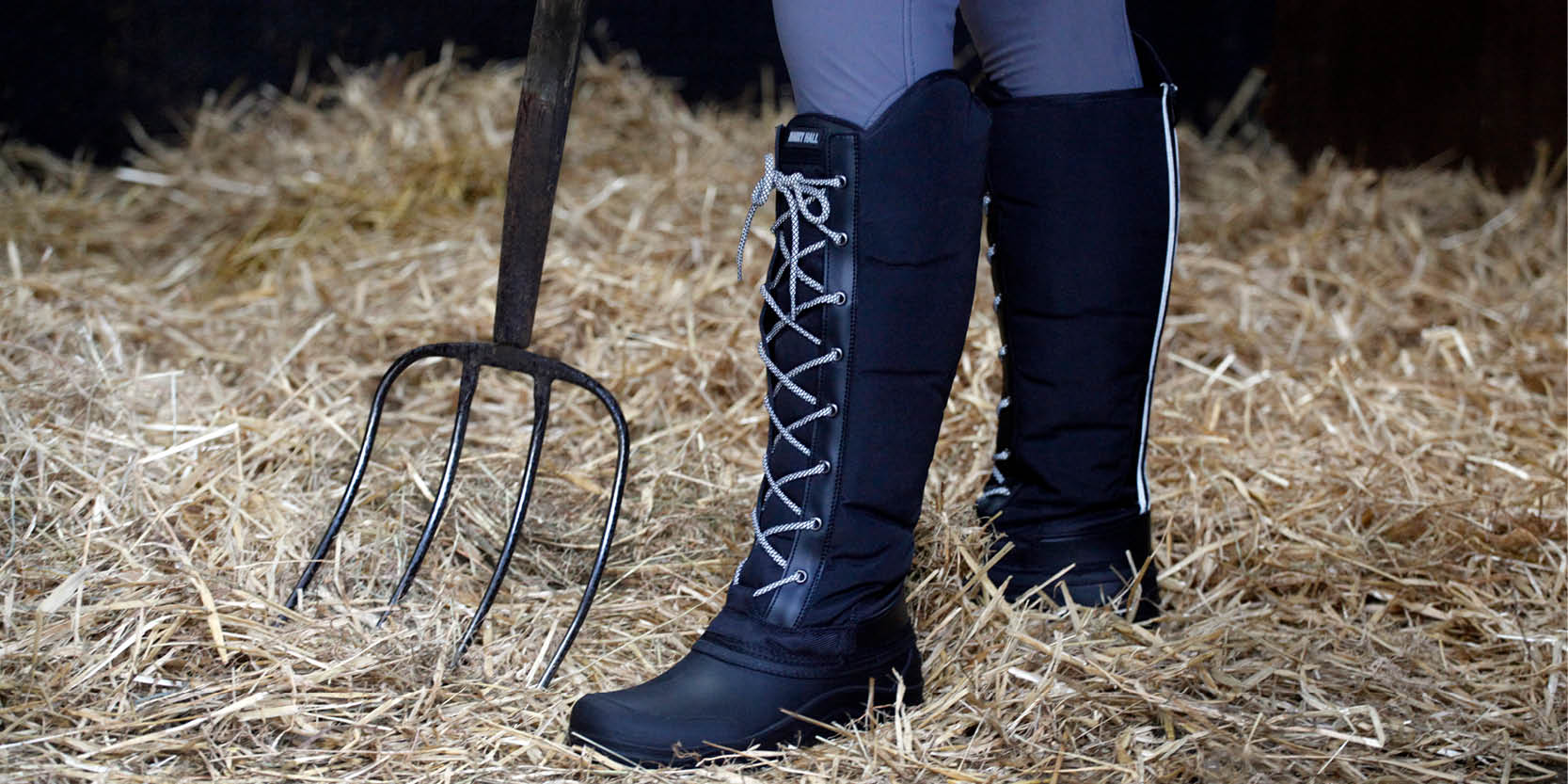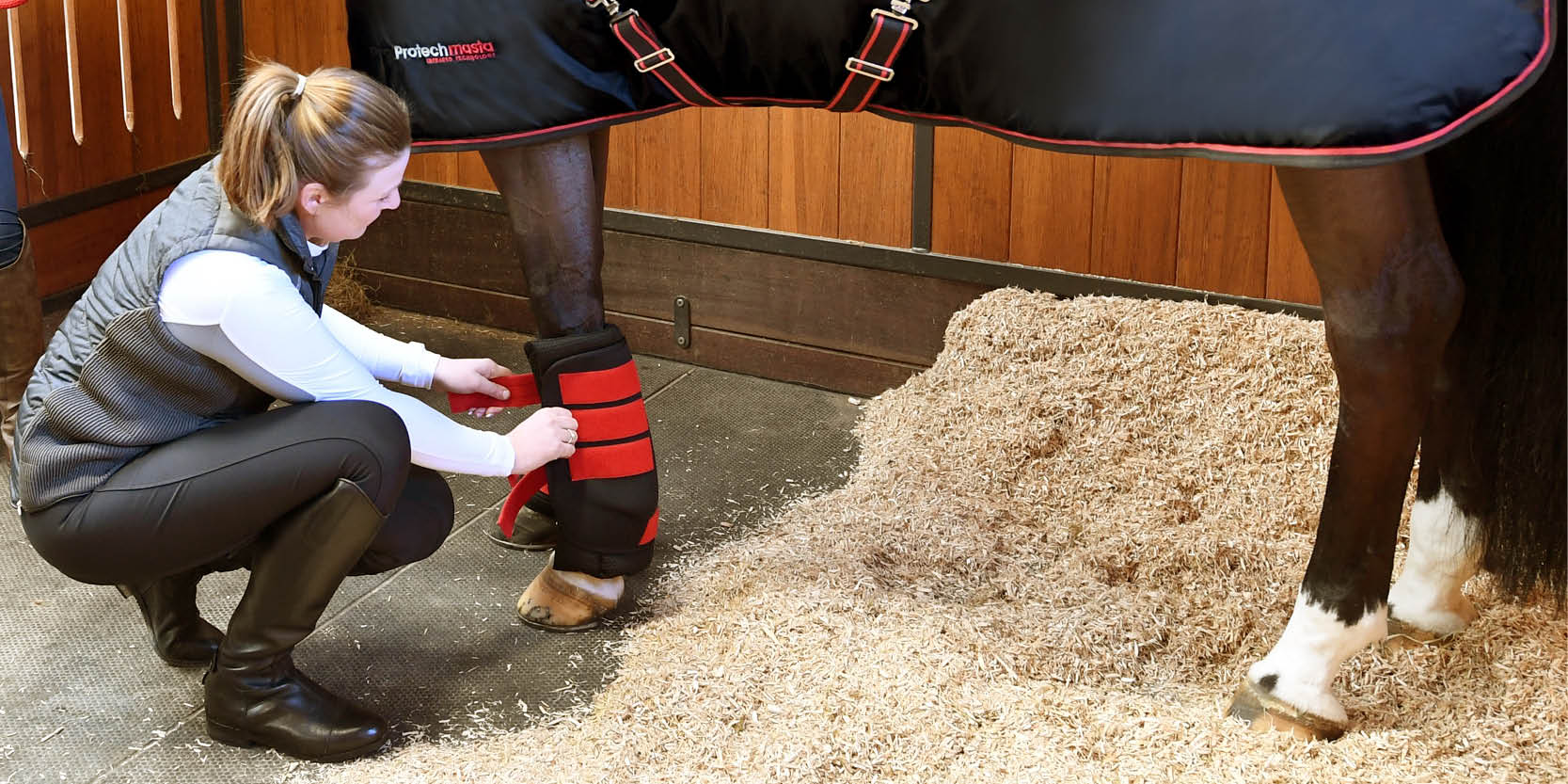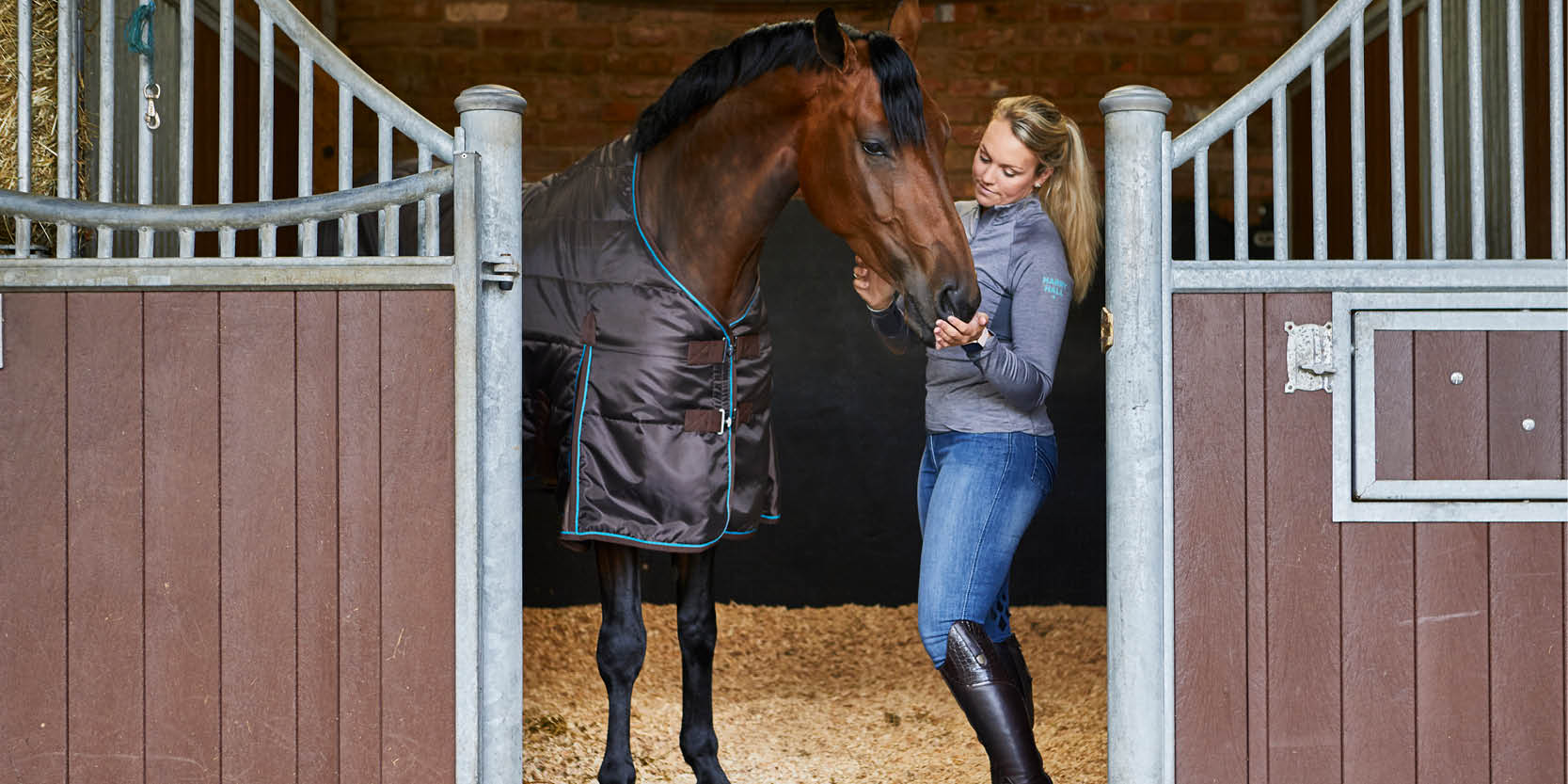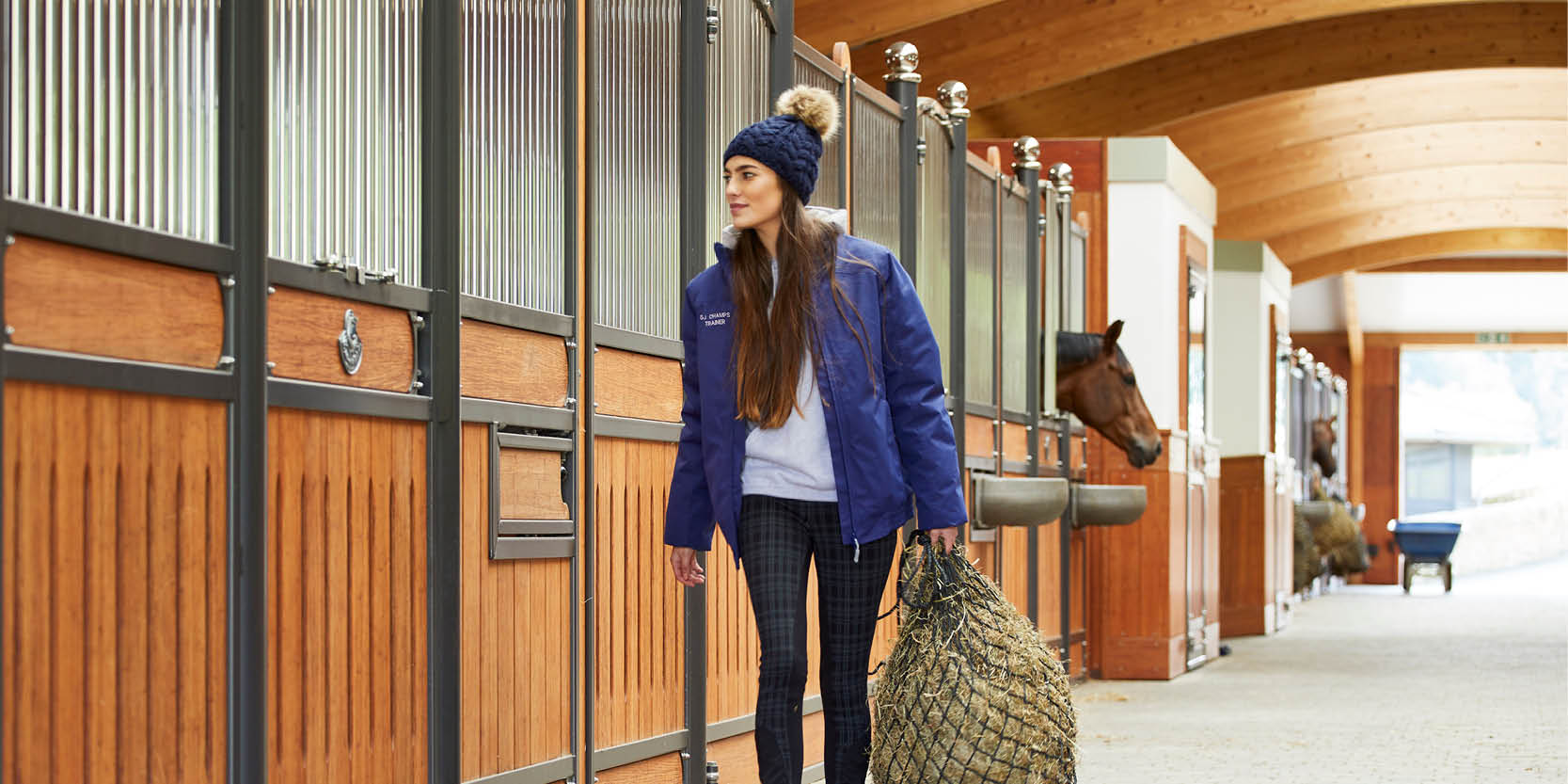
When non-equestrians say “I love clean sheets” an equestrian’s mind immediately jumps to that fresh stable feeling. Banks are perfectly formed and squared off at the edges, and not a blade of straw or flake of shavings is out of shape. The front of the stable is swept up so neatly your gran would be proud, and you leave thinking: “I’d sleep on that”.
For many, perfecting an immaculate stable for our horses to relax in is an addiction. Some equestrians have even been known to hoover their stable and paint it monthly to keep it looking tip-top (1).
So what is the best horse bedding for your horse to get a good night’s kip? What will make them snore until the cows come home and, more importantly, what will be easier on your pocket and not make your clothes smell for days? We’ll look at the pros and cons of horse bedding to help you decide what to bed down on.
What is the best horse bedding?
If we’re honest, we’re creatures of habit. The best horse bedding is often available locally at an affordable price. It’s only when we investigate what would be best for our horses that we might change our approach. It’s also worth thinking about where you will dispose of your bedding – how big can the muck heap get and who will spread it for you? Here are the main types of horse bedding readily available in the UK plus their pros and cons to help you decide what is the best horse bedding:
Straw horse bedding
A preferred choice for many and one of the most traditional forms of bedding, straw comes in three main types, wheat, barley and oat. Wheat is the type of straw most used in horse bedding as it’s readily available, it can be a dusty type of straw though so if your horse is prone to allergies steer clear of wheat straw. Barley is inexpensive but can be particularly prickly and could irritate your horse’s skin. Finally, there’s oat straw, this is the most palatable type of straw so not the ideal choice of bedding for horses.

Pros of straw horse bedding
Straw is relatively easy to get hold of and is an affordable way of providing a comfy bed for your horse. Equestrian Estate Agent Liz Langford is a fan of straw for this very reason. “Being on a farm, we have good access to straw, it’s also the most cost-effective bedding for my horses. Every 12 weeks I do a deep clean and find this works quite well.” Harry Hall Ambassador Katherine Kirby is also a fan of a straw bed, “it makes nice big beds and is easy to deep litter, straw is a cost-effective way of providing good quality bedding for our four horses.”
Did you know…
Many studs prefer to use straw during foaling season as shavings stick to newborn foals and it can be difficult for mares to clean their new foals. An essential part of the initial bonding process.
Cons of straw horse bedding
Some horses eat their bedding if on straw and while for many this isn’t a problem, some horses might not cope so well. Equine nutritionist Jennifer Little reminds us that horses can eat straw (2). “Some hay can be replaced with straw to aid weight loss whilst providing sufficient forage in the gut.” This comes with a warning, however. “Straw contains Lignin Fibers which a horse cannot digest. If a horse eats a large volume of straw, it can plug up its digestive system and result in colic. Horses can safely eat straw as 25% of their total forage amount.”
Straw can vary in quality and when one bale will be perfect, another could be dusty or mouldy. Add to this the odour that comes with straw. Some riders think straw smells more than other types of horse bedding making the stable-to-office commute a risky business. If the wet straw is removed daily, l’odeur ammonia shouldn’t become too much of a problem. Straw can also make for a large muck heap that if left uncontrolled, could take over the yard! It’s also not the most absorbent horse bedding available so you’ll go through more than you might expect.
Straw pellets are a good option to keep your muck heap in check however they can be hard to get hold of and are more expensive than traditional straw bales. They are also very palatable so might not be the ideal horse bedding for the good doer. Top tip - Is your horse getting enough fibre? An equine nutritionist can help you establish the best diet for your horse. Speak to local farmers and feed merchants about sourcing local straw. Straw is likely to come in large bales so ensure you can store your straw delivery before it arrives.
Miscanthus horse bedding
Miscanthus is becoming a popular alternative to traditional straw and offers a straw–shavings hybrid. Miscanthus is Elephant grass processed to become extremely warm and fibrous bedding that is more absorbent than straw or shavings. Due to its absorbent qualities, it often lasts longer than other types of bedding.

Pros of Miscanthus horse bedding
Miscanthus goes through a dust extraction process before being baled and is 100% organic as no fertilisers or chemicals are used on the crop. This means Miscanthus is kind to your horse’s skin and respiratory system. It’s less palatable than straw, especially when infused with lavender or eucalyptus, so your horse shouldn’t be tempted by a midnight snack.
It absorbs three times its weight and, for most horses, lasts longer than straw or shavings beds. On top of this, it is easy to muck out and dispose of, rotting quickly too.
Cons of Miscanthus horse bedding
While more economical than shavings, depending on the supplier, it retails at an average of £8 - £11 for a 20 kg bag so is more expensive than straw and depending on your location, it can be hard to source Miscanthus. If your horse is prone to a messy, wet bed, miscanthus might not be the best option for you.
The team at Caviera Bedding supplies high-quality miscanthus horse bedding and delivers it nationwide. Shavings horse bedding A popular choice for horses who tend to eat their bedding, shavings provide excellent support for horses’ hooves and are an easy option for horse bedding.
Pros of shavings as horse bedding
Many brands available today are dust-free and larger flaked shavings. Shavings are generally easy to get hold of with most feed merchants having a good supply. Shavings are less susceptible to mould and are generally pretty good at absorbing liquids. They provide a consistent footing for horses so are a good choice of bedding for horses on prolonged periods of box rest.
Cons of shavings as horse bedding
Know your wood. Black Walnut wood shavings are highly toxic for horses and should be avoided. Wood-based muck heaps need to be turned regularly and given longer to rot before they can be spread on the land. This is because wood-based muck heaps leach nitrogen from the ground which can affect the PH levels of your soil meaning farmers won’t be interested in spreading a shavings muck heap on their land unless it is very well rotted.
Busy Veterinary Nurse Faye Robinson has her horse, Rosie, on sawdust, horse bedding with similar properties to shavings. Faye finds bedding her horse on sawdust and saves time on mucking out. “I like using sawdust because when multiple bags are added it compresses and forms a lovely thick bed that doesn’t move around as much as shavings and that soaks up urine well. I deep litter Rosie on sawdust so she has a thick, comfortable bed that can be cleaned out quickly. A huge plus when I’m on night shifts and cramming everything in!”
Top tip:
Be savvy with your sawdust. Extremely dusty sawdust could be a sign that your bedding might not be the best quality and could include unwanted objects such as screws, nails and other harmful objects swept up from the floor. If you’re using sawdust, it is advisable to use a good quality supplier. Equibed offer dust-free large flake shavings for horse bedding. Equibed offer dust-free large flake shavings for horse bedding.
Wood Pellets horse bedding
A popular alternative to traditional forms of horse bedding, horse bedding pellets made from wood are becoming a popular choice with horse owners. Wood pellets can make mucking out a breeze due to their high absorbency and are best used on top of good-quality rubber mats.
Jemma Govier moved to wood pellets for her horse Monty and hasn’t looked back since. “Monty can be quite a wet horse. He was going through his previous bedding quite quickly and I was having to replace two to three bags per week which became quite costly. I looked into alternative options and stumbled across wood pellets. It’s been a great decision for many reasons, but primarily it saves me so much time on mucking out. It’s incredibly cost effective compared to what I was paying and it lasts longer than any other bedding I’ve used, all round moving onto wood pellets has been a great decision.”
Pros of wood pellets for horse bedding
Wood pellets are a good option for horse bedding as you need less space to store them compared to straw or shavings bales. They’re highly absorbent and eco-friendly as well as keeping your muck heap to a minimum. Jemma found throughout the winter months, she only needed to use one to two bags of wood pellets every three weeks on Monty’s bed.
Cons of wood pellets for horse bedding
Wood pellets can be dusty in warmer weather so consider an alternative for these months if your horse is prone to allergies. Farmers tend not to be a fan of wood pellets as, like shavings, if not rotted properly they can affect the PH levels of the soil. So be aware that last year’s muck heap might linger for longer while it rots down properly before being spread.
Depending on your horse’s stable habits, and the brand of wood pellets you use, they might need soaking before laying down. Soaking the wood pellets needs to be built into your mucking out time, it can be a necessary step to make the pellets more comfortable to lie on. Based in Scotland, Sorbeo makes wood pellets for horse bedding and delivers them nationwide.
Using cardboard for horse bedding
The biggest enemy of the horse in the stable is dust. A dust-free bedding option such as cardboard can combat dust worries. Another benefit of using cardboard is that horses cannot eat it so as a form of horse bedding it is safe to use.
Do horses like cardboard for horse bedding?
Greenmile Equine Performance bedding based in Shropshire uses corrugated cardboard cut into fine strips, “cardboard is a natural insulator, it will trap the warm air created by your horse between its corrugations of paper keeping your horse’s bed cosy,” comments Joey Kinnersley from the horse bedding company. “It’s also highly absorbent, odour eliminating and 100% biodegradable.”
Pros of cardboard horse bedding
For most horse owners, cardboard is a cost-effective type of horse bedding that’s dust-free and it locks away the smell of ammonia – a huge bonus if you muck out before heading to work! It’s also fast rotting taking just 8 – 12 weeks to rot. On average, once your cardboard horse bed has been established, you’ll use one bale per week. A bale costs around £8 on a standard delivery of 30 bales making cardboard an affordable option for horse bedding. Cardboard will create a warm and supportive bed for your horse and a lot of people with cardboard horse bedding find a neat imprint in the bed where their horse lay down during the night.
Cons of cardboard horse bedding
Cardboard can be hard to muck out if you’re not used to it. Pieces will stick together when wet so if you want to just remove wet patches and droppings it could take you slightly longer to muck out than other types of horse bedding.
Due to its high absorbency, if you have a particularly wet horse, it might not be the one for you as you’ll have to replace a lot of the bed daily, meaning the costs will soar. It could also mean heavy barrows and numerous trips back and forth to the muck heap.
If you have a light-coloured horse, beware that when wet the colour of the cardboard can go onto your horse if they lie in a damp area. While it’s easy to wash off it might not help you at 5 am on the morning of a competition.
Do horses need bedding?
“Sleep, for horses is essential for overall equine health. Lack of sleep can seriously compromise a horse’s physical activity and quality of life. Sleep deprivation is common in horses and if the horse is stabled it can be triggered by environmental conditions such as stable size and bedding type,” comments Monica Aleman from the American Association of Equine Practitioners (3). Further research has found that straw is the best horse bedding for REM sleep as is the size of the bed. REM sleep is rapid eye movement sleep, for which a horse needs to lie down. Ensuring your horse has good quality REM sleep is important for their physical and mental health, performance, and lifespan (4).
Advantages of horse bedding
Horse bedding provides a comfortable and, when maintained correctly, hygienic environment for the stabled horse. It provides a comfortable base for your horse to lie down on and soaks up any mess they make while stabled. Bedding also provides support for your horse’s hooves when they’re standing. It avoids capped hocks or elbows and sores from forming and when they stand up from lying down, on horse bedding the can do so without slipping.
Disadvantages of horse bedding
The main disadvantage of horse bedding must be the cost and the rate at which some horses need their beds replenished. It can also lead to allergies and when managed incorrectly these can evolve into deeper problems as Lizzie Peck from Wood Farm Vet practice explains (5). “Reactions to bedding present similarly to other allergic reactions including coughing, sneezing, discharging eyes, hives, swelling, increased respiratory rate and effort. Most allergic reactions are mild but in extreme cases horses can develop respiratory distress, collapse or colic. Most allergic reactions occur within 24-48 hours of being exposed to the allergen, in this case, the bedding.”
What bedding is best for horses with allergies?
When it comes to treating horses with allergy sensitivities Lizzie advises that several options are available.
“Keeping your horse turned out 24/7 would be the ideal scenario but this is not always practically possible. Try to find a bedding that suits your horse. In most cases, it’s the dust within some bedding types that triggers the allergic reaction. Therefore, choose dust-extracted shavings, cardboard, paper or even wood pellets. If your horse is kept on a yard, neighbouring stables mustn't use dusty bedding either as this is likely to still affect your horse.
All bedding should be stored away from the stables which should all be well ventilated to improve airflow. Medications are available from your vet to help manage the symptoms of an allergic reaction including antihistamines, steroids and bronchodilators.” If despite trialling various types of bedding your horse is still showing signs of having allergic reactions, Lizzie advises putting in a call to your vet.
“They will be able to perform further investigations including allergy tests via intradermal testing or a blood test which can demonstrate what your horse is allergic to. This can then help you to tailor your horses’ management or consider immunotherapy to desensitise your horse to their specific allergic triggers.”

Some horses are prone to tucking into their bedding which can be a disadvantage if they eat too much of it. Eating horse bedding could cause an impaction which if left untreated could lead to colic and serious illness. If your horse is prone to eating their bedding, this could be down to boredom or a lack of fibre in their diet.
When considering what is the best horse bedding, look at alternative, less palatable types of bedding and ensure they have enough access to forage when stabled for long periods. Read more on respiratory disease in horses here.
How deep should horse bedding be?
The depth of a horse bedding can be determined by a few factors. Does the horse have rubber mats on top of the floor? Does the horse like deeper bedding and does the bedding type lend itself to deeper beds? Some horses don’t like thick beds whereas others will only lie down if the bedding offers sufficient support. Get to know your horse and monitor how much they are lying down to establish whether a thicker bed might be required.
How often should you change horse bedding?
Again, this depends on the horse and how messy or clean they are. It also depends on the type of bedding used. Ideally, wet straw should be removed daily whereas, with shavings, wood pellets and other products, their ability to absorb moisture means they can be left up to one week before being removed. Some people prefer deep littering, this means you put new bedding on top of old bedding to provide adequate comfort for your horse. When deep littering the whole stable is then cleared out in one go and replaced with fresh bedding.
Lizzie advises that using bedding with anti-bacterial properties can help you maintain hygienic stables. “It should be used alongside good stable care which includes mucking out any wet or soiled bedding, ensuring rubber mats are disinfected regularly and ensuring good ventilation to your stable. Anti-bacterial bedding can be particularly useful in managing cases of mud fever, wounds or dressings when it is essential to keep the horses’ environment dry and clean.”
How is horse bedding made?
How horse bedding is made depends entirely on what type of horse bedding you have. These days, a lot of horse bedding is made in an environmentally friendly way, free from chemicals and fertilisers. The best horse bedding will be dust-free and highly absorbent so look for these qualities when choosing what to bed your horse down on.

How much does horse bedding cost?
Again, the answer to how much does horse bedding costs depends on the type of horse bedding you opt for. Getting to know your horse’s stable habits will help you determine the best type of bedding for your budget. If your horse is particularly wet, straw might not be the best option. Look for something more absorbent such as Miscanthus. To avoid dust allergies, you might also have to spend a bit more on your horse bedding. Cardboard and high-quality wood pellets offer a good solution for this.
Horse bedding alternatives
We’ve all heard of straw, shavings and cardboard as options for horse bedding but what about peat, sand or shells and shives. While rare, these types of bedding do exist. Peat moss horse bedding is highly absorbent in terms of moisture and odour and the soft cushion-like nature of peat moss makes it a comfy bed for your horse. The major downside? To begin with, you have its cost and availability. Then throw on top the fact that aesthetically it isn’t the best horse bedding due to its dark colour. Then we have sand. Rare in its use as horse bedding because sand can increase the chances of sand colic if digested. It also has little to no absorbent qualities and can be abrasive on the horse’s coat.
Shells and shives are probably the least common type of horse bedding and one not many horse owners have heard of. This type of bedding is made up of hulls, shells and husks of nuts and grains. Shells and shives can be hard to get hold of in large enough quantities for horse bedding and some horse owners think it’s too slippery to put on the stable floor.
Finally, your horse bedding questions answered: Can dogs use horse bedding? Shavings and wood pellets are too dusty for your dogs and could plug up their eyes, nose and mouth. Hay and straw won’t be much good for our canine friends either as they create perfect habitats for bacteria, fleas and other insects to thrive. Stick to traditional dog beds and blankets for dog bedding.
Can horse lice live in bedding?
Yes! If you suspect your horse has lice, their bedding should be one of the first places to look as the potential source. Straw can be a perfect breeding ground for lice, if you suspect a bale has lice, you might want to dispose of the bales that have been placed near it too!
Where can I buy horse bedding near me?
Ask horsey friends, your local feed merchant or farms nearby if they supply or know of anyone who supplies good quality horse bedding. These days many companies deliver nationwide so search further afield for the best bedding for your horse. Forums and equestrian groups on Facebook are also good places to start (6).
Do horses need a rug when stabled?
Whether a horse needs a rug when stabled depends on the individual horse. For more information on whether your horse needs a rug or not, click here to read our handy rugging guide. As you have read, when considering what is the best horse bedding there are several factors to take into account. From affordability to availability and suitability, a one size fits all approach isn’t always the best way. If you have any concerns horse bedding might be affecting your horse’s respiratory system speak to your vet and research the best horse bedding before purchasing a lorry load.
Consider how you will store and dispose of the bedding too. Getting the right horse bedding is all about trial and error, either way, you’ll eventually find the best bedding to ensure your horse sleeps soundly.
